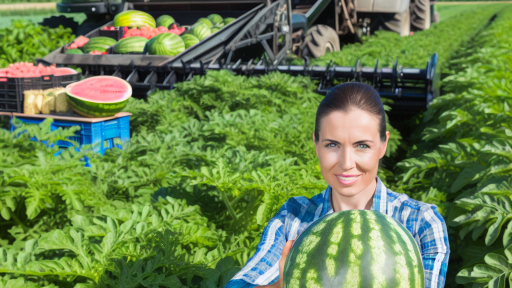Introduction to Community Supported Agriculture
Community Supported Agriculture, or CSA, connects small farmers with local consumers.
This innovative model allows customers to purchase shares of a farm’s harvest in advance.
Farmers benefit from upfront capital and a guaranteed market for their produce.
In turn, consumers enjoy fresh, seasonal products directly from their local farmers.
Structure of Community Supported Agriculture
Typically, a CSA operates on a subscription basis.
Customers subscribe to receive a box of assorted produce weekly or biweekly.
These boxes contain a variety of fruits and vegetables, reflecting the current season.
Farmers plan their crop choices based on subscriber preferences and seasonal availability.
Benefits for Small Farmers
CSAs offer several advantages for small farmers.
They provide stable income throughout the growing season.
This stability helps farmers plan better and reduce financial risks.
Moreover, a strong relationship with consumers fosters community support and loyalty.
Farmers can also receive immediate feedback from their subscribers.
Benefits for Consumers
Consumers gain access to fresh, organic, and local produce through CSAs.
They often discover new and unique varieties of fruits and vegetables.
Transform Your Agribusiness
Unlock your farm's potential with expert advice tailored to your needs. Get actionable steps that drive real results.
Get StartedThis model supports local economies by keeping food dollars within the community.
Additionally, it encourages healthier eating habits with seasonal produce.
Challenges of Community Supported Agriculture
Despite its benefits, CSAs face some challenges.
Seasonal availability can lead to fluctuations in the variety of items.
Some consumers may find it difficult to adapt to irregular produce amounts.
Furthermore, marketing can be challenging for farmers without experience.
Successful Examples of CSA
Many successful CSAs have emerged across the country.
For instance, Green Meadow Farm in Vermont has garnered a loyal following.
They emphasize transparency and community involvement in their operations.
Similarly, Sunshine Acres in California offers workshops to educate subscribers.
These examples illustrate the potential success of a well-managed CSA.
Benefits of CSA for Small Farmers
Stable Income Stream
Community Supported Agriculture (CSA) provides small farmers with a reliable income.
This income arrives early in the growing season.
Customers pay upfront, which helps farmers manage cash flow.
Consequently, farmers can focus more on production.
Strengthened Community Connections
CSA fosters a strong bond between farmers and consumers.
This supports local economies by encouraging local spending.
Regular communication brings transparency to the farming process.
Members become invested in the farm’s success and sustainability.
Diversity of Offerings
CSAs allow farmers to diversify their crop production.
Farmers can experiment with new varieties and heirloom plants.
This diversification attracts a broader customer base.
Hence, it enhances the resilience of the farm’s business model.
Reduced Marketing Effort
Participating in CSA significantly lowers marketing costs.
Showcase Your Farming Business
Publish your professional farming services profile on our blog for a one-time fee of $200 and reach a dedicated audience of farmers and agribusiness owners.
Publish Your ProfileFarmers rely more on direct sales rather than traditional retail outlets.
This direct engagement lifts the burden of extensive advertising.
Farmers can invest time and resources back into farming operations.
Enhanced Customer Loyalty
CSAs often cultivate strong customer loyalty.
Members feel a direct connection to their food sources.
They appreciate the stories behind producing their food.
This loyalty leads to continued support season after season.
How CSA Works
Structure of Community Supported Agriculture
Community Supported Agriculture (CSA) creates connections between farmers and consumers.
In a CSA, members buy shares of the farm’s harvest in advance.
This structure provides farmers with upfront capital for their operations.
Additionally, it offers consumers access to fresh, locally grown produce.
Members receive weekly or bi-weekly deliveries of seasonal produce.
Each share typically includes a variety of vegetables, fruits, and herbs.
Some CSAs also offer eggs, dairy, or meat products.
This variety encourages members to try new recipes and foods.
Membership in a CSA
Membership in a CSA involves a commitment to support local agriculture.
Consumers typically sign up for one growing season at a time.
Payment often occurs upfront, helping farmers plan their crops.
This commitment fosters a strong connection between consumers and farmers.
Members often visit the farm to learn about farming practices.
They may also participate in harvest days or farm events.
This engagement creates a sense of community around food production.
Benefits for Small Farmers
CSAs provide vital support for small-scale farmers.
By securing upfront payments, farmers can invest in their operations.
Also, they can reduce food waste by planning harvests based on membership sizes.
Moreover, farmers benefit from direct relationships with consumers.
This direct connection encourages transparency and trust.
Furthermore, CSAs enable farmers to diversify their crops.
By growing a variety of crops, they can mitigate risks associated with market fluctuations.
Ultimately, CSA membership strengthens local economies and food systems.
Discover More: Sustainable Livestock Management Tips
Challenges Faced by Small Farmers in CSA Implementation
Financial Constraints
Small farmers often struggle with limited financial resources.
Start-up costs for a CSA can be significant.
They need to invest in seeds, equipment, and marketing.
Additionally, upfront expenses can strain tight budgets.
Ongoing operational costs also pose challenges.
Market Competition
Small farmers face intense competition from larger farms.
These larger enterprises often benefit from economies of scale.
As a result, they can offer lower prices to consumers.
This price disparity can deter potential CSA members.
Showcase Your Farming Business
Publish your professional farming services profile on our blog for a one-time fee of $200 and reach a dedicated audience of farmers and agribusiness owners.
Publish Your ProfileLogistical Challenges
Coordinating deliveries can be a complex task.
Farmers must ensure timely distribution of produce.
Inconsistent weather conditions can disrupt schedules.
Therefore, planning becomes crucial for success.
Consumer Engagement
Building a loyal customer base requires effective marketing.
Small farmers often lack the resources for extensive promotion.
They must find innovative ways to attract customers.
Community outreach and education are essential components.
Educational Barriers
Many small farmers lack knowledge of CSA models.
They may need training in farm management and marketing.
Access to resources and workshops can be limited.
Continuous learning is vital for adapting to market needs.
Regulatory Challenges
Navigating regulations can be overwhelming for small farmers.
They often face compliance hurdles relating to food safety.
Understanding local, state, and federal laws is essential.
These regulations can require time and financial resources.
Explore Further: Soil Health Management for Small-Scale Farmers
Marketing Strategies for Small Farmers in CSA
Understanding the CSA Model
Community Supported Agriculture, or CSA, creates a direct connection between farmers and consumers.
In this model, consumers purchase a share of the harvest in advance.
This approach provides farmers with upfront capital and ensures a steady customer base.
Identifying Target Markets
First, identify your target demographic for your CSA program.
Families looking for fresh produce often fall into this category.
Additionally, health-conscious individuals may prioritize local, organic foods.
Reach out to local community centers, schools, and health clubs for potential members.
Creating Compelling Marketing Materials
High-quality visuals can showcase the farm’s produce and practices.
Utilize social media to share stunning images of your crops.
Videos can also be effective; share farm tours or recipe ideas using your products.
Furthermore, provide clear information about CSA membership benefits.
Engaging with the Community
Build relationships within your local community to increase visibility.
Participate in farmers’ markets and local events to showcase your offerings.
Host open farm days to invite potential members to experience your farm firsthand.
Engagement fosters trust and makes consumers more likely to join your CSA.
Developing a User-Friendly Sign-Up Process
Make the sign-up process quick and straightforward.
Offer online registration through a user-friendly website.
Moreover, provide clear instructions and options for payment methods.
It’s essential to make this process accessible for all potential members.
Utilizing Feedback for Improvement
Encourage CSA members to provide feedback on their experience.
Surveys can help identify areas for improvement and highlight successful strategies.
Responding to member feedback fosters loyalty and enhances the overall experience.
Regular communication about farm updates and future offerings keeps members engaged.
Showcase Your Farming Business
Publish your professional farming services profile on our blog for a one-time fee of $200 and reach a dedicated audience of farmers and agribusiness owners.
Publish Your ProfileFind Out More: Promoting Ethical Farming In Communities

Success Stories: Case Studies of Small Farmers Using CSA
Innovative Practices at Green Acres Farm
Green Acres Farm is a shining example of successful CSA implementation.
This small family-owned farm started its CSA program three years ago.
Initially, they struggled to attract members.
They adapted their offerings based on community input.
Today, they provide a large variety of seasonal vegetables.
Members appreciate the flexibility of customizable boxes.
Additionally, farm events foster a strong community spirit.
Green Acres now has over 100 dedicated members.
This growth allows the farm to thrive financially.
Helping Hands Organic Farm’s Community Focus
Helping Hands Organic Farm prioritizes community engagement.
They began their CSA to promote local organic produce in their area.
Regular newsletters keep members updated and involved.
They also organize pick-your-own days for members.
This interaction builds relationships between farmers and consumers.
With over 80 subscribers, the farm sees consistent growth.
This strong base provides financial stability while supporting local food systems.
Pine Tree Farm’s Unique Offerings
Pine Tree Farm differentiates itself with unique offerings.
They specialize in heirloom vegetables and exotic herbs.
Members enjoy fresh produce not typically found in grocery stores.
This uniqueness captures the interest of local chefs.
Many patrons appreciate the exclusive recipes shared by the farm.
Pine Tree Farm’s CSA has increased its membership year after year.
They now support a vibrant local food movement.
Expanding Horizons at Sunny Hill Farms
They collaborate with nearby farms to diversify their products.
This strategy enriches their CSA offerings significantly.
Members receive not only vegetables but dairy and baked goods.
Such collaboration strengthens their community presence.
This approach has doubled their membership within two years.
Sunny Hill proves that teamwork enhances local agriculture.
Lessons Learned from Successful CSA Farmers
Successful CSA farmers demonstrate adaptability and communication.
They listen to their members’ needs and preferences.
Effective marketing plays a crucial role in attracting new members.
Moreover, community events foster loyalty and trust.
Lastly, collaboration with other local producers increases value.
These shared lessons pave the way for sustainable farming success.
See Related Content: Sustainable Soil Management Practices
Sustainability and Environmental Impact of CSA Models
Benefits of Community Supported Agriculture
Community Supported Agriculture (CSA) fosters a direct connection between farmers and consumers.
This relationship promotes sustainable practices and local food systems.
Showcase Your Farming Business
Publish your professional farming services profile on our blog for a one-time fee of $200 and reach a dedicated audience of farmers and agribusiness owners.
Publish Your ProfileIn addition, CSA models reduce the carbon footprint associated with long-distance transportation.
By focusing on local production, farmers can quickly respond to seasonal changes.
This adaptability leads to fresher produce for consumers.
Emphasis on Organic Farming
Many CSAs prioritize organic farming practices.
Organic methods enhance soil health and promote biodiversity.
Moreover, these approaches limit the use of synthetic fertilizers and pesticides.
This commitment protects local ecosystems and water sources.
Ultimately, organic farming contributes to healthier food options for communities.
Strengthening Local Economies
CSAs empower small farmers by providing reliable income streams.
This financial support fosters economic resilience in rural areas.
Consumers benefit from knowing their purchases support local economies.
Furthermore, CSAs create jobs in fields such as packaging, distribution, and marketing.
This employment boosts the local workforce and community well-being.
Enhancing Food Security
CSAs play a crucial role in improving food security.
They ensure access to fresh produce for families, especially in urban areas.
Additionally, they often offer a variety of fruits and vegetables throughout the season.
This diversity encourages healthier eating habits among consumers.
Furthermore, CSAs provide educational resources on nutrition and cooking.
Challenges and Solutions
Despite their many benefits, CSAs face challenges.
One common issue is the upfront cost of membership.
Farmers can address this by offering payment plans to consumers.
Another challenge is ensuring consistent quality and variety.
Farmers can mitigate this by diversifying crops and establishing partnerships with other producers.
Ultimately, overcoming these hurdles strengthens the CSA model.
Future Trends in CSA and Small Farming
Embracing Technology
Small farmers are increasingly adopting technology to enhance efficiency.
They utilize apps for crop management and market access.
Drone technology is becoming popular for monitoring crops and livestock.
Moreover, online platforms connect farmers directly with consumers.
Focus on Sustainability
Sustainable practices are gaining traction among small farmers.
This approach reduces environmental impact and improves soil health.
Farmers are exploring organic farming and regenerative agriculture.
These methods not only improve product quality but also appeal to consumers.
Diverse Crop Options
Diversifying crop offerings can help mitigate risks.
Farmers are experimenting with heirloom varieties and specialty crops.
Such diversity caters to niche markets and local restaurants.
As a result, it boosts profits and enhances food security.
Community Engagement
Community engagement is essential for the success of CSAs.
Farmers are hosting events to educate local consumers about agriculture.
They offer workshops on cooking and preserving fresh produce.
This builds strong relationships and creates a loyal customer base.
Showcase Your Farming Business
Publish your professional farming services profile on our blog for a one-time fee of $200 and reach a dedicated audience of farmers and agribusiness owners.
Publish Your ProfileAdapting to Climate Change
Climate change poses significant challenges for small farmers.
Farmers are adapting by choosing climate-resilient crops.
Water conservation techniques are becoming increasingly vital.
Additionally, farmers collaborate with researchers for innovative solutions.
Enhanced Marketing Strategies
Effective marketing is crucial for small farming success.
Farmers are utilizing social media to reach a wider audience.
They create engaging content to attract and retain subscribers.
Partnerships with local businesses further enhance visibility.
Additional Resources
INSPIRED Food Markets, Nutrition & Community Dynamics Report …
Community Supported Agriculture | National Agricultural Library




